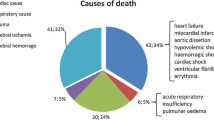Abstract
Human skin allografts are one of the best temporary biological coverings for severely burned patients. Cryopreserved (CPA) and glycerol-preserved (GPA) allografts are the most widely used types. This study compared the allograft efficiency of both preservation methods under the same conditions. To simulate actual clinical conditions, we used a porcine wound model. In addition, we evaluated the macroscopic and microscopic scoring of graft performance for each method. Porcine cadaver skin 1 mm thick was obtained from one pig. Cryopreserved skin cell viability was 20.8 %, glycerol-preserved skin was 9.08 %, and fresh skin was 58.6 %. We made ten partial-thickness wounds each in two pigs. The take rates on day 2 were 96.23 and 82.65 % in the GPA and CPA group (both n = 9), respectively. After 1 week, the take rates of both groups were nearly equal. The removal rate at week 5 was 98.87 and 94.41 % in the GPA and CPA group, respectively. On microscopic findings at week 2, inflammation was greater in the CPA group. Other findings such as fibroblast hyperplasia and neovascularization were not significantly different between both groups. At week 5, the score of collagen fiber synthesis was 2.67 ± 0.47 and 2.33 ± 0.47 in the GPA and CPA group, respectively. The epidermal-dermal junction was 2.22 ± 0.79 and 2.00 ± 0.47 in the GPA and CPA group, respectively. These findings suggest that wound healing takes longer in the CPA group. The preservation method of allografts is not a absolute factor in the wound healing process in this wound model.










Similar content being viewed by others
References
Baxter CR (1985) Skin banking in the USA. J Burn Care Rehabil 6:322
Branski L, Mittermayr R, Herndon DN et al (2008) A porcine model of full-thickness burn, excision and skin autografting. Burns 34:1119–1127
Burd A, Lam PK, Lau H (2002) Allogenic skin: transplant or dressing? Burns 28(4):358–366
Cleland H, Wasiak J, Dobson H et al (2014) Clinical application and viability of cryopreserved cadaveric skin allografts in severe burn: a retrospective analysis. Burns 40:61–66
Gaucher S, Nicco C, Jarraya M et al (2010) Viability and efficacy of coverage of cryopreserved human skin allografts in mice. Int J Low Extrem Wounds 9(3):132–140
Hermans MH (1998) Results of a survey on the use of different treatment options for partial and full thickness burns. Burns 24(6):539–551
Hermans MH (2007) Results of an internet survey on the treatment of partial thickness burns, full thickness burns, and donor sites. J Burn Care Res 28(6):835–847
Hermans MH (2011) Preservation methods of allografts and (lack of) influence on clinical results in partial thickness burns. Burns 37:873–881
Herndon DN (2012) Total burn care, 4th edn. Elsevier
Hussmann J, Russell RC, Kucan JO et al (1994) Use of glycerolized human allografts as temporary (and permanent) cover in adults and children. Burns 20(Suppl 1):S61–S65
Khoo TL, Halim AS, Saad AZ et al (2010) The application of glycerol-preserved skin allograft in the treatment of burn imjuries: an analysis based on indications. Burns 36(6):897–904
Kua EH, Goh CQ, Ting Y (2012) Comparing the use of glycerol preserved and cryopreserved allogenic skin for the treatment of severe burns: differences in clinical outcomes and in vitro tissue viability. Cell Tissue Bank 13(2):269–279
Larsen CP, Steinman RM, Witmer-Pack M et al (1990) Migration and maturation of Langerhans cells in skin transplants and explants. J Exp Med 172(5):1483–1493
Meyer W, Scharz R, Neurand K (1978) The skin of domestic mammals as a model for the human skin with special reference to the domestic pig. Curr Probl Dermatol 7:39–52
Prudue GF, Hunt JL, JrJM Still et al (1997) A multicenter trial of a biosynthetic skin replacement Dermagraft-TC, compared with cryopreserved human cadaver skin for temporary coverage of excised burn wounds. J Burn Care Rehabil 18:52–57
Richters CD, Hoekstra MJ, van Baare J et al (1997) Immunogenicity of glycerol-preserved human cadaver skin in vitro. J Burn Care Rehabil 18(3):228–233
Sullivan TP, Eaglstein WH, Davis SC (2001) The pig as a model for human wound healing. Wound Repair Regen 9:66–76
Vloemans AF, Middelkoop E, Kreis RW (2002) A historical appraisal of the use of cryopreserved and glycerol-preserved allograft skin in the treatment of partial thickness burns. Burns 28(Suppl 1):S16–S20
Acknowledgments
The work presented in this paper was supported by Research Funds from the Korea Foundation For Human Tissue Donation (KFTD).
Author information
Authors and Affiliations
Corresponding author
Ethics declarations
Conflict of interest
All the authors have no conflicts of interest that could inappropriately influence the above work.
Rights and permissions
About this article
Cite this article
Yoon, C., Lim, K., Lee, S. et al. Comparison between cryopreserved and glycerol-preserved allografts in a partial-thickness porcine wound model. Cell Tissue Bank 17, 21–31 (2016). https://doi.org/10.1007/s10561-015-9521-x
Received:
Accepted:
Published:
Issue Date:
DOI: https://doi.org/10.1007/s10561-015-9521-x




